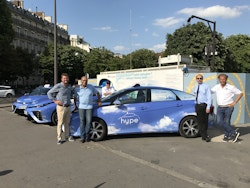Hype Taxis: hydrogen-powered taxis for all in the heart of Paris
Quick dive in the history of those who are revolutionizing clean transport in the capital.

The first fleet of hydrogen-powered taxis in the world
Launched in Paris on December 7, 2015, during the United Nations Climate Change Conference (COP21), in partnership with Air Liquide, the fleet of Hype Taxis then consisted of five vehicles and officially became the first of its kind in the world. It now counts close to 75. Hydrogen-powered vehicles have several advantages: range of over 500 km, refueling in 3 to 5 minutes, no noise and no emissions except water vapor. These qualities therefore make it an ideal solution for the depollution of megapolises, and one that is perfectly adapted to the professional constraints faced by passenger.
“The key difference compared to battery-powered electric vehicles is that it is not necessary to immobilize the vehicle. It is easier to ask drivers to adopt hydrogen because it will not change their working methods.”
The multiplication of hydrogen applications
In partnership with Air Liquide and Toyota, Hype Taxis, just like Energy Observer, show the vital role that is played by hydrogen in “facilitating and speeding up the necessary energy transition of urban taxis,” according to Mathieu Gardies, and “implementing a fleet of taxis helps demonstrate this to the public in a concrete manner.”
Since this first Parisian hydrogen fleet, other major cities have inaugurated theirs: Ulsan in Korea, Hamburg in Germany, and Aberdeen in Scotland. More and more megalopolises are turning to hydrogen transport for their transport infrastructure, such as London and Tokyo, which are studying the possibility of setting up a fleet of hydrogen taxis of their own. Brussels is also preparing to receive a fleet of 60 hydrogen Hype Taxis, scheduled for the second half of 2018. A symbolic location for the development of hydrogen, since Europe multiplies initiatives in favor of this energy vector.
The hydrogen fleet was a partner of Energy Observer during its inaugural stopover in Paris in July 2017.

Energy Observer and Hype for clean mobility
Objective: 600 hydrogen taxis before the year 2020
In twenty-seven months, the hydrogen taxis already display 1.4 million kilometers traveled on their odometers and 200,000 people transported, and Hype continues to accelerate its development. Two years after its launch, the fleet consisted of nearly 75 vehicles at the end of 2017, and aims to reach 200 vehicles by the end of 2018 and 600 before the end of 2020.
STEP, Parisian Electric Taxi Company, which manages the first fleet of hydrogen taxis, is hoping to deploy the taxis internationally, with projects to expand to other French and European cities.
The deployment of the Hype Taxi fleet is closely related to the development of hydrogen-production and distribution facilities. One single station provides 200 kg of hydrogen each day, ensuring the supply of 50 to 70 vehicles per day. Air Liquide, a minority shareholder in STEP, plays a proactive role in the deployment of recharging infrastructures and allows the development of the Hype fleet by opening stations in Paris and surrounding areas. Following the station in Paris-Orly, which opened at the end of 2017, two new charging stations have been planned for Paris in 2018: the first, in Versailles, has been in operation since February, and the second will open in Roissy. They will enable hydrogen-powered taxis to broaden their field of operation. A tender has been launched in the capital to grow the fleet by 130 new cars, calling on various automobile manufacturers.
Tomorrow’s transport starting today
Hype Taxis not only run without emitting CO2 or fine particles, but they also provide carbon-free hydrogen, that is to say a hydrogen produced in a clean and environmentally friendly way.
A mobile application is already available and allows you to try hydrogen transport for yourself by placing an immediate order (reservations cannot be made yet). Given that the fleet in circulation is still reduced, it remains shy on its communication so as not to cause frustration. For its part, the Energy Observer team continues to call on the zero-emissions company to get around in the capital city.